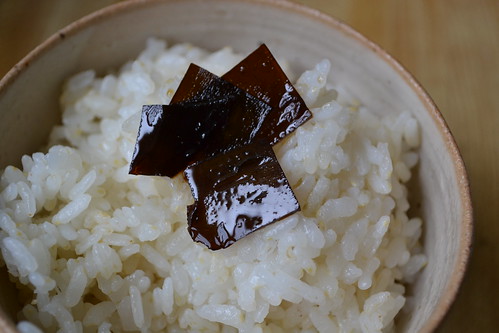
I am home in Berkeley after taking a week-long road trip through the American southwest with fellow Umamimart writer
Anders, bookended by a five-day trip in NYC. I am so excited to be back in my own kitchen that I've stocked up on everything from soft shell crab to chicken thighs for curry. But those ingredients will have to wait. The only thing I crave now is a bowl of hot white rice with some humble
tsukudani.
Making
kombu tsukudani served two purposes. Softening the
kombu would serve as the base for my
dashi. The
kombu itself would later be seasoned for the most comforting meal I could think of after two weeks of:
Salty lunches...
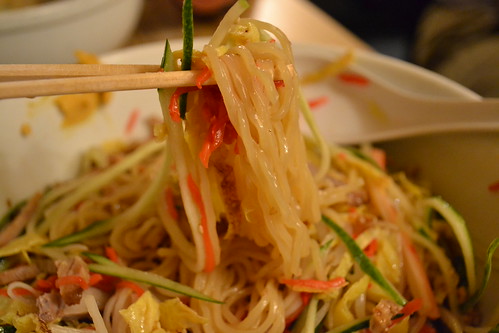 Hiyashi Chuka at Menkui-tei, NYC
Hiyashi Chuka at Menkui-tei, NYC
Artery clogging indulgences...
 The Burger Joint, NYC
The Burger Joint, NYC
And perfect plates...
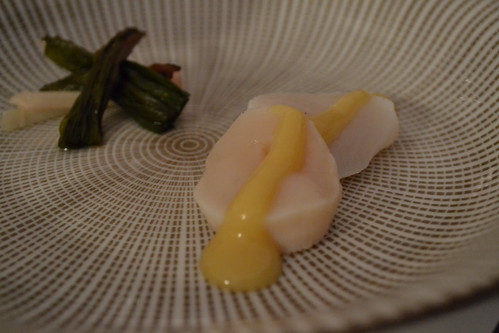 The Ra(m)p'n Scallop at Chez Yamahomo, NYC
The Ra(m)p'n Scallop at Chez Yamahomo, NYC
It might seem redundant to post about another
tsukudani recipe, but I found that the method for
kombu tsukudani is a bit different from fish-shaving
tsukudani.
INGREDIENTS
1 square foot of kombu that has been used for extracting dashi brought back to room temperature.
4 tbsp shoyu (soy sauce)
4 tbsp
mirin
4 tbsp sake
1 tbsp sugar
1 1/2 cups of dashi
METHOD
1. Initial softening of
kombu involves soaking it in water (room temperature) for at least 20 minutes. I let my
kombu sit for about 40 minutes. I then made
dashi out of it by adding fish shavings and bringing it up to a boil.
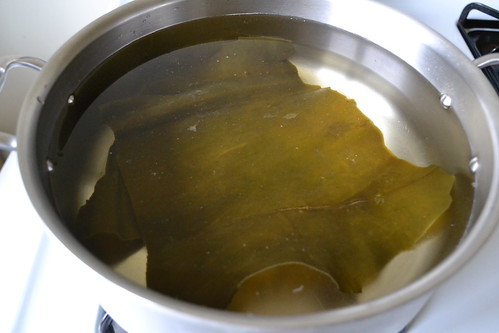
2. After bringing the liquid up to a boil, fish the
kombu out of the pot and bring back to room temperature. The liquid is now
dashi.
3. Cut
kombu into 1/2 inch square or smaller if you prefer.
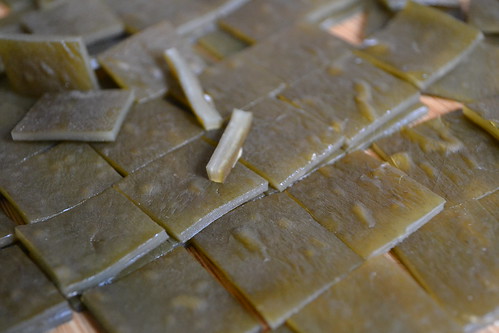
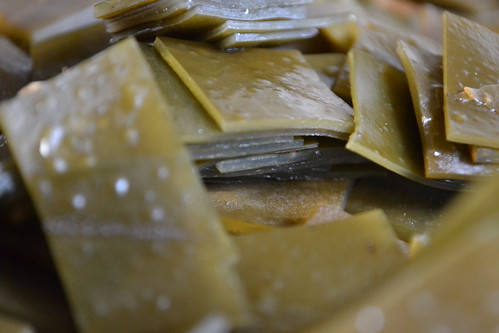
4. Place the shoyu, mirin, sake, sugar and 1/2 cup of
dashi into a pot. Bring to a rolling boil (it'll happen quick).
5. On the lowest heat setting, add
kombu squares to the pot. Cover and simmer for 20 minutes. Make sure to keep an eye on it so it doesn't start burning.
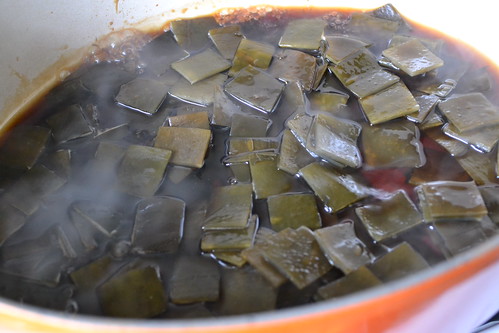
6. Add another 1/2 cup of
dashi and simmer for another 20 minutes.

Continue repeating this step until the
kombu softens. I found that my
kombu was pretty hard and kept adding more
dashi for the
kombu to soak up. You should not have to tear the
kombu with your teeth, it should fall apart easily when you bite into it. Other people may have different methods which I'd be happy to hear about.
7. Store in an air-tight jar or plastic container.
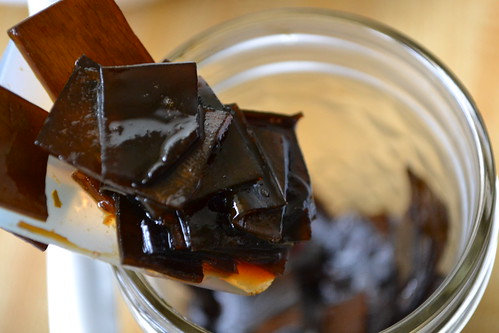
Jar it up!
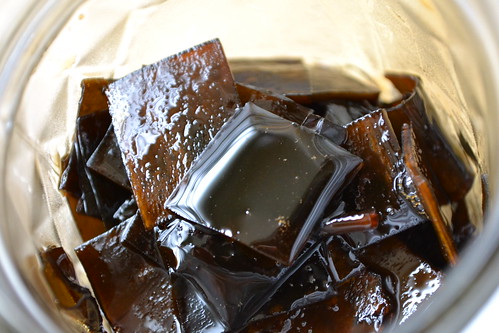
Being cooked and cleaned for is paradise, but another kind of paradise is making your own food and putting leftovers in the fridge for later.
 I am home in Berkeley after taking a week-long road trip through the American southwest with fellow Umamimart writer Anders, bookended by a five-day trip in NYC. I am so excited to be back in my own kitchen that I've stocked up on everything from soft shell crab to chicken thighs for curry. But those ingredients will have to wait. The only thing I crave now is a bowl of hot white rice with some humble tsukudani.
Making kombu tsukudani served two purposes. Softening the kombu would serve as the base for my dashi. The kombu itself would later be seasoned for the most comforting meal I could think of after two weeks of:
Salty lunches...
I am home in Berkeley after taking a week-long road trip through the American southwest with fellow Umamimart writer Anders, bookended by a five-day trip in NYC. I am so excited to be back in my own kitchen that I've stocked up on everything from soft shell crab to chicken thighs for curry. But those ingredients will have to wait. The only thing I crave now is a bowl of hot white rice with some humble tsukudani.
Making kombu tsukudani served two purposes. Softening the kombu would serve as the base for my dashi. The kombu itself would later be seasoned for the most comforting meal I could think of after two weeks of:
Salty lunches...
 Hiyashi Chuka at Menkui-tei, NYC
Artery clogging indulgences...
Hiyashi Chuka at Menkui-tei, NYC
Artery clogging indulgences...
 The Burger Joint, NYC
And perfect plates...
The Burger Joint, NYC
And perfect plates...
 The Ra(m)p'n Scallop at Chez Yamahomo, NYC
It might seem redundant to post about another tsukudani recipe, but I found that the method for kombu tsukudani is a bit different from fish-shaving tsukudani.
INGREDIENTS
1 square foot of kombu that has been used for extracting dashi brought back to room temperature.
4 tbsp shoyu (soy sauce)
4 tbsp mirin
4 tbsp sake
1 tbsp sugar
1 1/2 cups of dashi
METHOD
1. Initial softening of kombu involves soaking it in water (room temperature) for at least 20 minutes. I let my kombu sit for about 40 minutes. I then made dashi out of it by adding fish shavings and bringing it up to a boil.
The Ra(m)p'n Scallop at Chez Yamahomo, NYC
It might seem redundant to post about another tsukudani recipe, but I found that the method for kombu tsukudani is a bit different from fish-shaving tsukudani.
INGREDIENTS
1 square foot of kombu that has been used for extracting dashi brought back to room temperature.
4 tbsp shoyu (soy sauce)
4 tbsp mirin
4 tbsp sake
1 tbsp sugar
1 1/2 cups of dashi
METHOD
1. Initial softening of kombu involves soaking it in water (room temperature) for at least 20 minutes. I let my kombu sit for about 40 minutes. I then made dashi out of it by adding fish shavings and bringing it up to a boil.
 2. After bringing the liquid up to a boil, fish the kombu out of the pot and bring back to room temperature. The liquid is now dashi.
3. Cut kombu into 1/2 inch square or smaller if you prefer.
2. After bringing the liquid up to a boil, fish the kombu out of the pot and bring back to room temperature. The liquid is now dashi.
3. Cut kombu into 1/2 inch square or smaller if you prefer.

 4. Place the shoyu, mirin, sake, sugar and 1/2 cup of dashi into a pot. Bring to a rolling boil (it'll happen quick).
5. On the lowest heat setting, add kombu squares to the pot. Cover and simmer for 20 minutes. Make sure to keep an eye on it so it doesn't start burning.
4. Place the shoyu, mirin, sake, sugar and 1/2 cup of dashi into a pot. Bring to a rolling boil (it'll happen quick).
5. On the lowest heat setting, add kombu squares to the pot. Cover and simmer for 20 minutes. Make sure to keep an eye on it so it doesn't start burning.
 6. Add another 1/2 cup of dashi and simmer for another 20 minutes.
6. Add another 1/2 cup of dashi and simmer for another 20 minutes.
 Continue repeating this step until the kombu softens. I found that my kombu was pretty hard and kept adding more dashi for the kombu to soak up. You should not have to tear the kombu with your teeth, it should fall apart easily when you bite into it. Other people may have different methods which I'd be happy to hear about.
7. Store in an air-tight jar or plastic container.
Continue repeating this step until the kombu softens. I found that my kombu was pretty hard and kept adding more dashi for the kombu to soak up. You should not have to tear the kombu with your teeth, it should fall apart easily when you bite into it. Other people may have different methods which I'd be happy to hear about.
7. Store in an air-tight jar or plastic container.
 Jar it up!
Jar it up!
 Being cooked and cleaned for is paradise, but another kind of paradise is making your own food and putting leftovers in the fridge for later.
Being cooked and cleaned for is paradise, but another kind of paradise is making your own food and putting leftovers in the fridge for later.




Comments (7)
I am making it right now, and it’s been like 30 minutes and they are not tender!! How long did you cook for?
Yeah, I ended up cooking them for like an hour. And it’ll get more tender once you turn off the heat and just let them chill out in the pot until they come to room temp.
It got tougher after I turned off the heat. I am recooking, but not going anywhere. It’s been like 2 hours. Maybe the konbu were just not good….
That’s weird… Maybe there is something wrong with the kombu?
I was telling my friend about it, and she simply said konbu that are available in the US are low grade, to be exclusively used to make dashi, so they may be tougher then good ones. I even added salt pickled shiso leaves, and flavor is very good, but it’s so tough…
Never made before tonight. I soaked for 2 hrs. Then added rice vinegar,soaked another hr or so. Then when I finally cooked it,it was tender in 20 minutes. Just soak it longer!
Hi, I have loads of Kombu that I need to use up, so will be trying this recipe out. Reading elsewhere it also says soaking for longer helps as does adding vinegar (as it helps tenderise the Kombu. See this alternative link for some other tips:
http://justbento.com/handbook/johbisai/homemade-shio-kombu-kombu-no-tsukudani